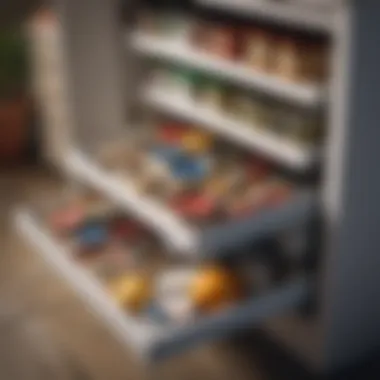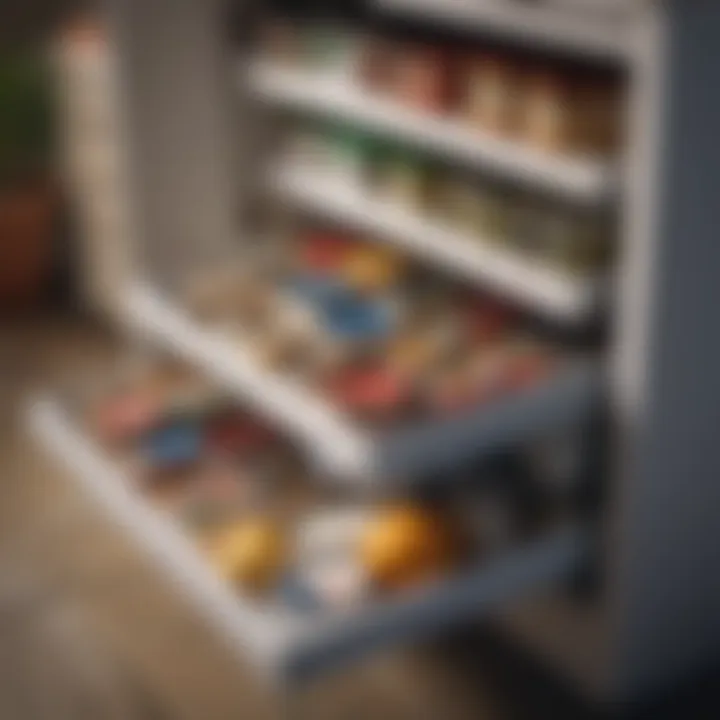Pantry Organization Drawers: Efficient and Aesthetic Solutions


Intro
A well-organized pantry is more than just a storage space; it plays a crucial role in the efficiency of daily tasks and contributes to the overall aesthetic of the home. For homeowners, interior design enthusiasts, and even party hosts, the pantry can enhance both functionality and style. Proper organization allows for easy access to ingredients and kitchen supplies, reducing time spent searching for items. Understanding the strategies to capitalize on drawer systems within the pantry can lead to significant improvements.
In this article, we will explore various strategies for pantry organization. By offering insights into design inspirations, maintenance, and specific organizational tools, readers can expect to learn how to transform their pantries into visually appealing and efficient spaces.
Let’s delve into the aspects that contribute to creating a pantry that is both practical and charming.
Design Inspirations
Aesthetics can elevate the functionality of a pantry. Design inspirations encompass not just the arrangement of items but also the style and color palettes used within the space. This section will unleash some ideas aimed at creating a visually satisfying pantry experience.
Trending Styles
Modern pantries often adopt clean, minimalistic styles. Open shelving allows for easy visibility, while integrated drawer systems optimize space. Rustic designs featuring natural wood finishes provide warmth and character. Considerations for traditional styles may also include classic cabinetry that offers a timeless appeal.
Key styles to explore include:
- Contemporary: Clean lines, neutral colors, and a minimalist approach ensure storage is stylish yet practical.
- Industrial: Use of metals and reclaimed materials can create a strong, urban vibe in the pantry.
- Farmhouse: This style emphasizes rustic elements, which might include distressed wood and vintage accents, ensuring a cozy feel.
Color Palettes
Choosing the right colors can enhance the pantry's mood. Research suggests that light hues can create the illusion of more space. Soft whites or light pastels encourage brightness and openness. For those looking for a bolder look, deep hues like navy blue or forest green can be striking when paired with complementary accents.
Popular color combinations include:
- Soft gray with white accents
- Navy blue paired with warm beige
- Pastel tones mixed with natural wood finishes
Maintenance and Upkeep
Maintaining a well-organized pantry goes beyond initial setup; it requires regular upkeep to ensure continued efficiency. Staying on top of pantry organization allows homeowners to enjoy the long-term benefits of their efforts.
Seasonal Maintenance Checklist
Changing seasons can affect pantry inventories. A checklist might include:
- Assessing items for expiration dates and freshness
- Rearranging items according to use frequency
- Restocking essentials and seasonal ingredients
- Organizing for upcoming occasions like holidays or gatherings
Cleaning and Organization Tips
To keep your pantry in top shape, consider these tips:
- Regularly clean shelves and wipe down surfaces to avoid spills and crumbs.
- Use clear containers for dry goods to identify contents easily.
- Categorize items into groups, such as baking supplies, snacks, or canned goods, for ease of access.
- Label bins and containers clearly for quick identification of items.
A well-organized pantry promotes an enhanced experience when cooking or preparing for events. By integrating design inspirations and maintaining an organized system, homeowners can achieve a pantry that reflects both efficiency and beauty.
"An organized pantry is the foundation of an efficient kitchen."
In summary, the strategies for pantry organization centered around drawer systems can significantly impact how the space functions and looks. Utilizing appropriate styles and colors, alongside proper maintenance, is key to a pantry that is both pleasing to the eyes and practical.
Intro to Pantry Organization
An organized pantry is fundamental to maintaining a functional kitchen. It is the backbone of meal preparation and storage. An efficient pantry not only enhances productivity but also contributes significantly to visual appeal. Homeowners often overlook the potential impact of a well-ordered pantry on daily life. When items are easy to find and access, cooking becomes less of a chore and more enjoyable.
Considering design aspects alongside functionality fosters an environment conducive to creativity. Home cooks and busy individuals alike can benefit from a personalized approach to pantry organization. This article explores drawer systems as a key strategy to harness both efficiency and aesthetics in pantry spaces.


Importance of an Organized Pantry
A disorganized pantry leads to frustration. Items get misplaced, and the time spent looking for them adds unwelcome stress. An organized pantry increases ease of use. Simply knowing where ingredients are stored saves time and enhances the cooking experience.
Moreover, an orderly pantry minimizes food waste. When all items are visible, it reduces the chances of forgetting about ingredients that may go bad. Clear visibility promotes accountability, encouraging homeowners to rotate their stock and utilize older items first.
An intentional organization system also encourages healthier eating habits. When pantry items are arranged neatly, it becomes easier to choose nutritious options. The act of organizing can feel invigorating, creating a space that reflects your personal style while serving functional requirements. This energizes the culinary experience and can even inspire new recipe creations.
Overview of Drawer Systems
Drawer systems play a vital role in pantry organization. They allow for maximum space utilization and provide easy access to items. Several types exist, including pull-out drawers, stackable units, and built-in solutions. Each type has its unique advantages, so understanding these options can simplify the selection process.
Pull-out drawers are particularly beneficial for deep cabinets. They slide out with ease, allowing users to view what's inside without needing to dig through items. This method enhances accessibility considerably.
Stackable drawer units are versatile. They can adapt to different pantry sizes and can be adjusted based on needs. This features compact designs that work well in tight spaces.
Built-in drawer solutions are customized to fit within existing cabinetry. They can be designed to use the available space optimally, often accommodating various sizes of containers and jars. These systems contribute to a seamless look, further enhancing the aesthetic value of the kitchen.
Utilizing drawer systems effectively contributes to not only an organized pantry but also a visually appealing one, making it a key consideration in the overall home design.
An efficiently organized pantry can transform cooking from a mundane task into an enjoyable experience.
Types of Drawer Systems for Pantries
Drawer systems in pantries are essential for creating an organized and accessible space. The way these systems are designed can greatly impact both the functionality and aesthetic of the pantry. Each type of drawer system offers unique benefits which cater to different needs. Understanding these options is crucial for effective pantry organization.
An efficient pantry means easy access to ingredients and no more wasted time rummaging through various containers. Additionally, a well-organized pantry looks visually pleasing, which can enhance the overall décor of a kitchen. When selecting a drawer system, one must consider factors such as available space, item types, and individual cooking habits. This evaluation will help in choosing the most suitable drawer system for your pantry.
Pull-Out Drawers
Pull-out drawers are particularly popular for their ease of use and accessibility. They extend fully, allowing homeowners to reach items at the back of the cabinet without difficulty. This feature can be beneficial, especially for deeper pantry spaces, where it is easy to forget what lies hidden at the back.
When organizing with pull-out drawers, it is wise to keep frequently used items at the front. This keeps the pantry functional while maximizing space. It is also suggested to use clear containers within these drawers to quickly see what you have. Pull-out drawers can come in various materials, such as wood or metal, and can be adjustable to cater to various item sizes.
Stackable Drawer Units
Stackable drawer units provide a versatile organization option for pantries with limited space. These units can be stacked vertically, increasing storage capacity without requiring additional floor space. They are especially useful for smaller kitchens or apartments where maximizing vertical space is key.
These units often offer flexibility in design. They may feature transparent fronts to allow visibility of contents. This design is ideal for pantry items like snacks, spices, and dry goods. When using stackable drawer units, it is practical to group similar items together. This method enhances efficiency when cooking or baking and speeds up access to essential ingredients.
Built-In Drawer Solutions
Built-in drawer solutions are an investment in both aesthetics and organization. These systems integrate directly into the cabinetry, providing a seamless look that complements the overall design of the kitchen. They can be customized to fit any pantry size and shape, allowing for optimal use of space.
One significant benefit of built-in drawers is the ability to design them specifically to accommodate larger items, such as bulk goods or pots. Proper planning during the design phase ensures that once installed, these drawers can streamline the cooking process significantly. Keep in mind that these solutions usually require professional installation but can add considerable value to a home.
"An organized pantry is not just about storage but also about enhancing the cooking experience."
The selection of drawer systems for pantries is critical for achieving a combination of efficiency and aesthetics. Each type of drawer system has its advantages and considerations, and the final choice should reflect both personal needs and kitchen design.
Key Principles for Effective Pantry Organization
Organizing a pantry is not merely an aesthetic endeavor; it is a foundational aspect of efficient kitchen management. Understanding the key principles for effective pantry organization can streamline cooking processes and enhance the overall user experience. These principles not only help in storing food items but also make them easy to locate, thus saving time and effort.
Assessing Your Needs
Before diving into the organization process, it is crucial to assess your specific needs. This step is about understanding your cooking habits and how often you use certain ingredients. Consider the following aspects:
- Frequency of Use: Identify ingredients you use regularly. Common items might be rice, pasta, or condiments.
- Quantity: Evaluate how much of each item you typically purchase, as this affects the space you require.
- Type: Different categories of food like baking supplies, canned goods, and snacks should have distinct storage requirements.


An honest assessment allows you to curate a pantry space that aligns perfectly with your lifestyle.
Categorizing Items
Once you've assessed your needs, next is categorizing the items in your pantry. This principle is essential for maintaining order and ensuring quick access to what you need. Consider organizing items into specific groups:
- Dry Goods: Store items like grains, nuts, and seeds together.
- Canned and Jarred Food: Group these items to keep them within easy reach.
- Snacks and Treats: Keep these separate for easier selection, especially if children are involved.
- Baking Supplies: Position flour, sugar, and other essentials in one accessible area.
Organizing by category not only simplifies the search process but also encourages a mindful approach to cooking and meal preparation.
Prioritizing Accessibility
Access to items is critical in a well-organized pantry. Prioritizing accessibility means placing frequently used items at eye level or in the front of drawers, while less-used items can be stored in the back. Here are practical suggestions:
- Eye-Level Placement: Items that are used daily should be easy to see and grab.
- Use Clear Containers: Transparent storage allows immediate identification of contents, reducing search time.
- Label Everything: Labels can help you quickly locate what you want and prevent clutter.
By emphasizing accessibility, you create a functional space that enhances your cooking operations and makes pantry management effortless.
"A well-organized pantry is like a silent partner in the kitchen, facilitating creativity while minimizing frustration."
Selecting the Right Organizational Tools
Selecting the appropriate organizational tools is critical for achieving both efficiency and aesthetics in any pantry. The right tools can significantly enhance accessibility, making it simpler to find and retrieve items. When the pantry is structured well, it saves time and reduces frustration during meal preparation. Furthermore, visually appealing tools contribute to an overall pleasant atmosphere, which can make kitchen tasks more enjoyable.
In order to make informed choices about these tools, it is vital to consider the specific dimensions of the pantry, the types of items stored, and personal preferences. Subsequently, this tailored approach will lead to a well-ordered space where everything has a designated place.
Baskets and Containers
Baskets and containers are essential for creating a neat and organized pantry. They help contain similar items together, minimizing chaos. Both can be used to store dry goods, snacks, or even small kitchen utensils. When selecting baskets, consider materials like wicker, plastic, or metal, as each offers unique aesthetics and functionality.
Additionally, containers come in various styles, including clear plastic and glass options. Clear containers allow visibility, making it easy to identify contents at a glance. On the other hand, decorative baskets can add charm and character while serving a functional purpose. It is important to ensure that the size of baskets and containers aligns with the pantry’s dimensions to effectively utilize the available space.
"Well-organized storage solutions not only enhance efficiency but also elevate the overall visual appeal of a pantry."
Labels and Tags
Labels and tags play a crucial role in maintaining order in pantry organization. They provide clear identification of contents, allowing anyone to find items quickly and efficiently. Proper labeling is particularly beneficial when multiple similar items are present, such as various grains or snacks. Therefore, implementing a consistent labeling system can greatly improve usability.
When choosing labels, consider durability and design; materials such as laminated paper, vinyl, or chalkboard labels can withstand wear while providing elegance. Additionally, the font style and size should be chosen with readability in mind. Depending on personal preference, labels can be placed directly on containers or affixed to shelves for broader categorizations.
Drawer Dividers
Drawer dividers are a practical tool for maximizing drawer space in the pantry. They create compartments for different item categories, thus preventing items from mixing and allowing a more streamlined access. Dividers can vary in size and material, from adjustable plastic to sleek wooden options, enabling customization according to drawer dimensions.
While organizing utensils, snacks, or pantry staples, dividers help in keeping everything tidy and within reach. This solution can especially benefit drawers that hold multiple smaller items. Ensuring that the dividers are flexible enables the user to rearrange sections as needed, accommodating seasonal changes in pantry contents. This adaptability further enhances the system's overall effectiveness.
Strategies for Maintaining Organization
Maintaining an organized pantry goes beyond initial setup. It is a dynamic process that requires attention to detail and regular updates. Effective strategies to maintain organization are crucial for ensuring that the pantry remains functional and visually appealing.
This section will discuss key strategies such as conducting regular audits, implementing seasonal updates, and fostering good habits. Each of these strategies contributes not only to the longevity of the organized state but also enhances the overall user experience with the pantry.
Regular Audits
Conducting regular audits is paramount in maintaining pantry organization. An audit entails a systematic review of pantry contents, checking for expired items, mismanaged storage, or underused products. Benefits of regular audits include:
- Ensured Freshness: Disposing of expired items keeps your pantry healthy and safe for consumption.
- Space Optimization: Identifying unneeded items allows for better utilization of available space.
- Awareness: Regular reviews enhance your knowledge of what you own, preventing duplicate purchases.


To implement this effectively, consider conducting audits every three months. Look for trends, such as which items frequently expire or are rarely used. You may also want to establish a checklist for efficiency, noting areas requiring improvement.
Seasonal Updates
Seasons play a significant role in pantry organization. With holidays and changes in food availability, a pantry should adapt accordingly. Seasonal updates involve reassessing your storage needs to align with upcoming cooking habits.
For example:
- Preparing for Holiday Cooking: Before major holidays, identify essential items you will need and allocate drawer space for them.
- Summer Ingredients Storage: In summer, fresh produce may require different storage solutions than in winter. Use baskets or containers that allow for airflow to preserve freshness.
By regularly updating storage based on seasonality, you can enhance both functionality and aesthetic appeal, ensuring that items are always in optimal condition.
Encouraging Good Habits
Fostering good habits is a key element in sustaining pantry organization. Once an organized system is established, it is essential to maintain that system through consistent practices.
Consider these approaches:
- Simple Returning Methods: Always return items to their designated places after use. Establishing a straightforward method for reorganizing after usage is vital for consistency.
- Involvement of Family Members: Encourage everyone in the household to participate in pantry maintenance. This could mean teaching them where items go or involving them in the regular audits.
- Set Reminders: Use digital reminders to prompt routine checks or audits. This will help in avoiding clutter or disorganization over time.
Remember, the goal is to make organization a habit, not a chore.
By implementing these strategies, you can ensure that your pantry remains organized for the long term, enhancing both your kitchen's functionality and style.
Seasonal Adaptations in Pantry Organization
Seasonal adaptations in pantry organization are crucial for maximizing efficiency and ensuring your pantry aligns with current trends in cooking and food storage. Each season brings distinct cooking styles, ingredient availability, and culinary traditions that influence how we utilize our pantry space. By adapting the organization of pantry drawers accordingly, homeowners can not only enhance functionality but also create a visually appealing area that reflects seasonal themes.
One core benefit of seasonal adaptations is improved accessibility. During the summer, for instance, specific items such as grilling spices, marinades, or fresh herbs may be more frequently used. Ensuring these items are easily accessible in clearly labeled drawers can streamline meal preparation, making cooking less stressful during the busy summer months. Conversely, as the holidays approach, diversifying pantry organization to accommodate seasonal baking supplies and holiday-specific ingredients can transform a standard pantry into a festive preparation hub.
Additionally, seasonal adaptations allow for better inventory management. This means you can rotate your stock based on what’s currently in season, reducing waste and ensuring freshness. It also provides an excellent opportunity for decluttering—a process critical for any successful organization strategy.
Preparing for Holiday Cooking
The holiday season invites a flurry of activities in the kitchen, often involving elaborate meals and entertaining family and friends. Preparing your pantry for holiday cooking involves several strategic steps. Start by assessing which ingredients you use most frequently during this time, such as baking supplies, special spices, or canned goods for festive dishes.
- Allocate space for holiday essentials: Dedicate drawers specifically for items needed during this period. Group together flour, sugar, baking powder, and specialty ingredients like maple syrup or chocolate chips. This makes it easier to grab items without hunting through the entire pantry when recipes call for them.
- Update your inventory: Regularly check your pantry for adverse conditions that can affect food quality. Replace expired goods, and consider stocking up on necessities like nuts and dried fruits, as these are popular during the holidays.
- Utilize labels and bins: Clearly label containers or bins for quick identification. Labeling items will save time and also help family members find what they need quickly, minimizing chaos during busy cooking sessions.
"An organized pantry is a foundation for culinary success, especially during the bustling holiday season."
Summer Ingredients Storage
Summer brings a bounty of fresh produce that often requires special consideration when it comes to pantry organization. Being mindful of how to store summer ingredients can enhance their freshness and prolong their usability.
- Create a seasonal drawer for fresh herbs and produce: If you grow your own herbs or purchase them frequently, having a designated space allows for easy access. Use breathable containers or mesh bags to keep herbs fresh longer.
- Incorporate clear containers: Select clear bins or jars to store summer staples like tomatoes, zucchini, or corn. This clear visibility will help remind you of what you have on hand, encouraging the use of fresh ingredients before they spoil.
- Adjust for meal prep: During summer months, meal prep usually includes lighter dishes like salads and grilling options. Organizing pantry drawers to reflect this—such as keeping dressing ingredients and salad toppings together—can make the meal prep process quicker and simpler.
By thoughtfully adapting pantry organization to reflect seasonal demands, homeowners can enjoy a more efficient and aesthetically pleasing kitchen environment. This adaptability not only makes cooking easier but also contributes to a more enjoyable culinary experience.
Culmination
Effective pantry organization significantly impacts both functionality and aesthetics, as discussed throughout this article. A well-structured pantry is not merely a place for food storage; it becomes a core element in home management and design. By integrating various drawer systems and strategies, you can optimize your space, making it both efficient and visually appealing.
Recap of Key Takeaways:
- Drawer Types: Different drawer systems exist, such as pull-out drawers and built-in drawer solutions, each serving specific needs.
- Organizational Tools: Selecting the right baskets, containers, and dividers is crucial to maintaining order.
- Maintenance Strategies: Regular audits and seasonal updates keep the pantry functional and prevent clutter.
- Seasonal Adaptations: Adjusting for different cooking seasons can enhance storage efficiency.
These strategies provide the tools necessary for a pantry that facilitates smooth cooking processes and enhances overall kitchen aesthetics.
"An organized pantry leads to a more efficient kitchen, making it easier to find what you need when you need it."
Final Thoughts on Pantry Organization:
Pantry organization is an ongoing process, requiring regular attention and adaptation to changing needs. Homeowners and design enthusiasts alike can greatly benefit from creating a system that prioritizes both accessibility and aesthetic appeal. A tailored approach ensures your pantry works for you, rather than the other way around. Immerse yourself in the task with an open mind and consider each element as a step towards a serene and functional space. In doing so, you will not only improve your cooking experience but also create a pantry that reflects your style and lifestyle.







